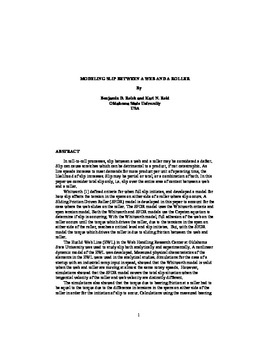| dc.contributor.author | Reish, Benjamin D. | |
| dc.contributor.author | Reid, Karl N. | |
| dc.contributor.other | International Conference on Web Handling (2019) | |
| dc.date.accessioned | 2019-06-04T16:16:37Z | |
| dc.date.available | 2019-06-04T16:16:37Z | |
| dc.date.issued | 2019-06 | |
| dc.identifier | oksd_icwh_2019_reid | |
| dc.identifier.citation | Reish, B. D., & Reid, K. N. (2019, June). Modeling slip between a web and a roller. Paper presented at the Fifteenth International Conference on Web Handling (IWEB), Stillwater, OK. | |
| dc.identifier.uri | https://hdl.handle.net/11244/320264 | |
| dc.description.abstract | In roll-to-roll processes, slip between a web and a roller may be considered a defect. Slip can cause scratches which can be detrimental to a product, if not catastrophic. As line speeds increase to meet demands for more product per unit of operating time, the likelihood of slip increases. Slip may be partial or total, or a combination of both. In this paper we consider total slip only, i.e. slip over the entire area of contact between a web and a roller. | |
| dc.description.abstract | Whitworth [1] defined criteria for when full slip initiates, and developed a model for how slip affects the tension in the spans on either side of a roller where slip occurs. A Sliding Friction Driven Roller (SFDR) model is developed in this paper to account for the case where the web slides on the roller. The SFDR model uses the Whitworth criteria and span tension model. Both the Whitworth and SFDR models use the Capstan equation to determine if slip is occurring. With the Whitworth model, full adhesion of the web on the roller occurs until the torque which drives the roller, due to the tensions in the span on either side of the roller, reaches a critical level and slip initiates. But, with the SFDR model the torque which drives the roller is due to sliding friction between the web and roller. | |
| dc.description.abstract | The Euclid Web Line (EWL) in the Web Handling Research Center at Oklahoma State University was used to study slip both analytically and experimentally. A nonlinear dynamic model of the EWL was developed. Measured physical characteristics of the elements in the EWL were used in the analytical studies. Simulations for the case of a startup with an industrial ramp input in speed, showed that the Whitworth model is valid when the web and roller are moving at almost the same rotary speeds. However, simulations showed that the SFDR model covers the total slip situation when the tangential velocity of the roller and web velocity are distinctly different. | |
| dc.description.abstract | The simulations also showed that the torque due to bearing friction at a roller had to be equal to the torque due to the difference in tensions in the spans on either side of the roller in order for the initiation of slip to occur. Calculations using the measured bearing friction on the roller of interest show that slip would not occur at speeds the EWL could attain. | |
| dc.description.abstract | In the experimental studies, a parasitic torque was applied to a roller mounted on load cells to create a slip condition. Hanging weights were used to apply the parasitic torque. An encoder was mounted on this roller to measure rotary velocity of the roller. Results from the experimental studies showed that the Whitworth model was valid only when the parasitic torque was small. In contrast, experimental studies showed that the SFDR model was valid only when the parasitic torque was large. | |
| dc.format | application/pdf | |
| dc.language | en_US | |
| dc.publisher | Oklahoma State University | |
| dc.rights | In the Oklahoma State University Library's institutional repository this paper is made available through the open access principles and the terms of agreement/consent between the author(s) and the publisher. The permission policy on the use, reproduction or distribution of the article falls under fair use for educational, scholarship, and research purposes. Contact Digital Resources and Discovery Services at lib-dls@okstate.edu or 405-744-9161 for further information. | |
| dc.title | Modeling slip between a web and a roller | |
| osu.filename | oksd_icwh_2019_reid.pdf | |
| dc.description.department | Mechanical and Aerospace Engineering | |
| dc.type.genre | Conference proceedings | |
| dc.type.material | Text | |
